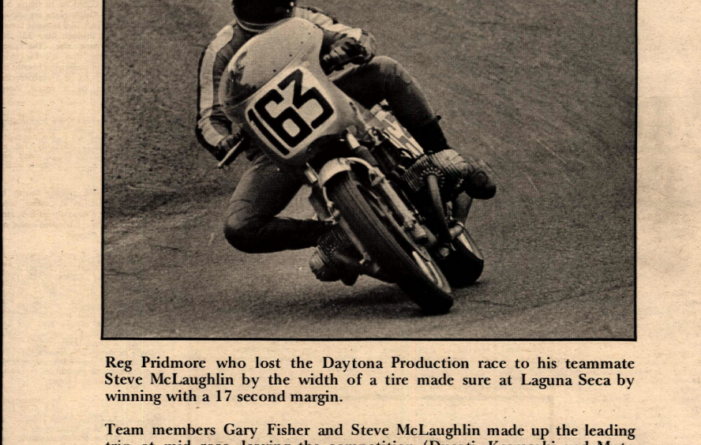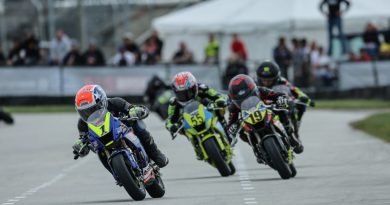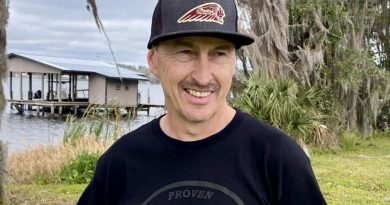Reg Pridmore: The First Superbike Champion
The following is the first in our 21 in ’21 features that will highlight the 21 AMA Superbike Champions each week as we move through the 2021 MotoAmerica season – the 45th year of the premier class championship.
Reg Pridmore was the first-ever AMA Superbike Champion in 1976. And the second and the third in ’77 and ’78. The Brit, who has called California home since his racing days, was there in the beginning of the AMA Superbike era, capturing his three straight titles on production-based, unwieldy four-strokes with bad brakes and hard, treaded tires.
Back then, the Superbike class was made up of naked, powerful, sit-up-and-beg-style motorcycles. Horsepower came in buckets. Handling… think thimbles. Simply put, they were a handful and far from the technological wonders they are today.
“We actually started talking Superbike before it really was,” Pridmore said of the beginnings of the class. “I mentioned that way back in ’74, ’75, things were moving up. Bikes were getting faster. A lot of bikes were having trouble with handling. It was a pretty exciting time, really, because we couldn’t manage the power so much, but it was one of those things where we were able to put our own abilities into it more so and make it work. That’s what I remember.”
Pridmore saw what streetbike-based racing could be like when he was in England. But even seeing that first-hand didn’t make him think it could turn into what it’s become.
“Coming from England and seeing what they did with the street classes that they had even way back then – you talk about the ’50s and ’60s. I envisioned it to grow pretty well, but I didn’t realize it would get as big as it is now.”
So, tell us what it was like, Mr. Pridmore, in those early years when you were armed with a Butler & Smith BMW R90S. At least in the beginning, it was the bike to have as it was actually sweet handling compared with the rest of the beasts in the upstart class.
“That’s a lot of words attached to that one,” he said. “I started mainly with the BMWs when it was around ’74, ’75. We had machinery that was capable, we thought. Club racing moved into professional (racing) pretty easily, but when it came to the different tracks and that, the BMW was sort of superior in its handling compared to a lot of the things I was running against. A lot of the brands were always complaining about what the front end is doing and what the back end is doing. It got to a point where you couldn’t convince people that it could get better if they just left it alone. But I wasn’t into teaching. I was into helping. Basically, I worked through a few of those bikes where people came back and showed good signs of becoming a champion.
“I remember Cook Neilson in ’77 Daytona, brilliant. Great job. Well-planned. Did a wonderful job. Although I won the championship that year, we didn’t quite exceed the top end that we really wanted, but he was pretty close. But I like consistency. If you do things repetitively to the point where they become a part of you, things develop and get better sooner. That’s what I had to do. I had to try that with the Kawasakis in ’77 and ’78, up to ’79 – until I had a pretty bad accident, or somebody caused a really bad accident for me, at Laguna Seca.”
The Superbike Championship wasn’t the main championship back then. Premier status remained with the two-strokes, the Formula One bikes of that era, but that would soon change.
“All the tracks that you talk about, we didn’t have many championship races,” Pridmore recalls. “I think only four or five. But the tracks grew, and the popularity grew. Nationally, and worldwide now, it’s just bitchin’ to watch as far as the bikes, the ability of the guys to make those things go round the corner. Of course, they’re not on those hockey pucks (tires) that we used to race on. They were guaranteed to wake up your day. In the rain, they became pretty tough. Nowadays, beautiful tires, bitchin’ tires, much better handling, good power, and it just goes on and on. You know the story.”
A lifelong motorcyclist, Pridmore still follows the sport and has owned and operated CLASS Motorcycle Schools since 1986. Motorcycles and road racing have been his life’s work. And they still are.
“From when it started when I was 15, it was a long time ago and it’s never let me down since,” Pridmore said. “All I’ve ever done is been around motorcycles. It’s been the biggest part of my life – that and flying. Those two come together pretty naturally. It had come down to the point where winning championships at that time had a lot of fun attached to it. The seriousness of today with the big money and so forth changed the scene a bit, as far as I’m concerned. But the guys are riding hard and ferociously. I think motorcycling being such a big part of my life has captured things like that picture behind me, flying F16s and flying the simulator of the SR-71. Bigger things in life don’t come, other than getting married, of course. Don’t forget that one.”
Right now, the motorcycle-riding school business is riding a high and CLASS is a big part of that.
“We have schools this year,” Pridmore said. “In fact. it blows my mind that the schools are filling (up) months and months ahead of the time, which is good. But I have knocked it back from 15 last year to 10 this year. Gigi (his wife) was scared to death from a certain person (on a motorcycle) that tried to impress her prior to knowing Reg Pridmore, and when we got together, she got to like bikes enough and I can’t say enough about her development. On a scale of one to 10, she’s pretty close to nine and 10, on a (BMW) 1000 RR. Some guys come in and say, ‘What did you do that for?’ She wanted to. That was it. That was the great part. She’s one of my best right-hands I could ever possibly want.”
Pridmore can’t count the number of motorcyclists he’s helped over the years – from newbies to returning customers… to police motorcyclists.
“I can sum it up fairly easily because I was an old racer,” he said of his teaching methods. “I really enjoy the fact that people are willing to learn if they listen, and they listen well. It can accomplish points right up to saving your life. I don’t teach racing at the track. I teach people how to be better, with more confidence, more control, more technique, and understand that the bike is your best friend to the point where it will do things for you now if you learn it, to the point where you’ll want to come back. You’ll want to do more of this. You’ll want to ride more. That’s what I’ve accomplished. I do get the occasional letter where it says, “Thanks, Reg. You saved my life.” That’s pretty good for me to hear that coming from people that I never really knew prior to them coming from school. As far as that goes, too, we have so many repeats (customers), which makes it really good for us that they sign up early. I got into teaching the police officers about five years ago. Now we can’t do enough for that. We usually acquire about 60 riders a day on that one. Sorting out the bad boys, they’re good. They’re really good. They know what they’re doing. On a scale of one to 10, they push the envelope to five, six, and seven. When you start opening up what eight, nine, and 10 can do for you, I think it helps them become more acquainted to what motorcycling is all about. It can be very safe. You just have to make it safe.”
To purchase tickets for all MotoAmerica events, click HERE
For information on how to watch the MotoAmerica Series, click HERE
For the full 2020 MotoAmerica Series schedule, click HERE



